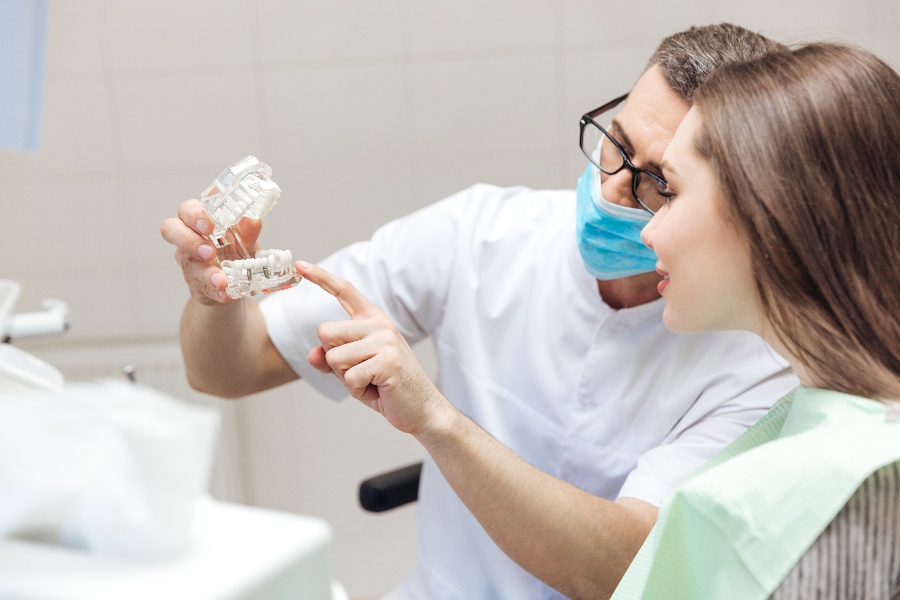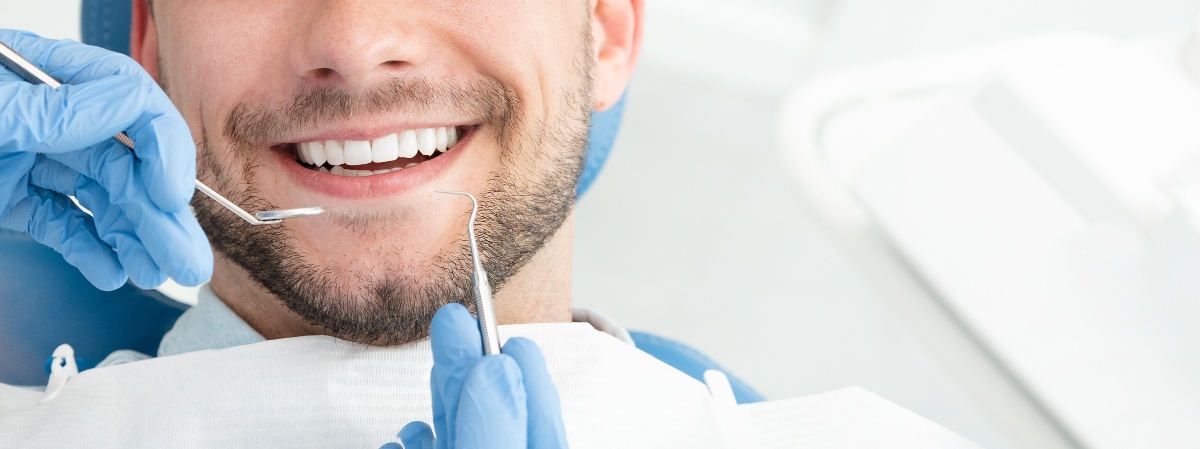Severely worn, damaged, and decayed teeth can affect more than your smile. The results of these conditions can include jaw pain, a misaligned bite, poor nutrition, and appearing older than your age. Fortunately, with full mouth rehabilitation, your dentist can restore most or all of your teeth to rebuild your bite and smile.
What Is Full Mouth Rehabilitation?
Full mouth rehabilitation, also known as full mouth reconstruction, is a comprehensive dental treatment plan that involves restoring or replacing all or nearly all of a patient’s teeth. It is typically recommended if you have extensive dental problems, such as missing or damaged teeth, gum disease, bite issues, or jaw problems, such as TMJ.
The process of full mouth rehabilitation can involve a combination of dental procedures, such as fillings, crowns, bridges, implants, and orthodontics, as well as periodontal treatment and possible jaw surgery. The goal is to create a healthy, functional, and aesthetically pleasing smile that improves oral health, self-confidence, and quality of life.
A full mouth rehabilitation requires careful planning and coordination between you, your dentist, and any needed dental specialists. The treatment plan will depend on your specific needs and goals, budget, and other factors.
The Importance of Full Mouth Rehabilitation for Smile Transformation
Full mouth rehabilitation is an important procedure for smile transformation for several reasons. It provides:
- A comprehensive restoration. A full mouth reconstruction addresses all aspects of oral health, from teeth and gums to bite and jaw alignment. This means you can have a complete and fully functional smile that looks and feels great.
- An aesthetic improvement. Full mouth rehabilitation can improve the appearance of your teeth and gums by correcting issues like discoloration, misalignment, and gaps between teeth. This results in a more confident and attractive smile.
- Improved oral health. Maximizing each tooth's appearance, health, and function helps resolve most underlying dental problems affecting your oral health, such as gum disease, cavities, and tooth decay. This means that your smile will not only look better but will also be healthier and more functional.
- Enhanced quality of life. You will enjoy a better quality of life with a healthy, beautiful smile. You will feel more confident in social situations, have an easier time speaking and eating, and experience less discomfort associated with dental problems.
Conditions That Can Benefit From Full Mouth Rehabilitation
Full mouth rehabilitation has helped many people with various conditions benefit from restoring most or all of their teeth to optimal function and aesthetics. These conditions include:
- Severely worn teeth. Teeth worn down from various factors can be restored to optimal size and shape with full mouth rehabilitation.
- Multiple missing teeth. Full mouth rehabilitation can replace multiple missing teeth with dental implants, bridges, or dentures to improve your ability to eat and speak and restore the appearance of your smile.
- TMJ disorder. TMJ disorder is a condition that affects the jaw joint and can cause pain, clicking, and limited mobility in your jaw. Full mouth rehabilitation can address this issue by realigning the bite and improving the overall function of your jaw.
- Gum disease. Gum disease, or periodontal disease, is a bacterial infection that can cause inflammation and damage to your gums and the bone supporting your teeth. This can result in red and swollen gums that affect your smile. Full mouth rehabilitation can treat this condition by removing the bacteria and restoring the health of the gums and bone. In addition, any teeth damaged by gum disease will also be restored.
- Traumatic injuries. If you have suffered a traumatic facial injury, you may benefit from full mouth rehabilitation to repair damage to your teeth and jaws.
- Malocclusion. Malocclusion, or a bad bite, is a condition where your teeth do not fit together correctly. This can cause several issues, such as difficulty biting and chewing, jaw pain, and premature wear on your teeth. Full mouth rehabilitation can correct malocclusion by combining treatments to make your bite more comfortable and improve the function of your teeth.
- Severe decay. Teeth severely damaged by decay may require full mouth rehabilitation to restore their function and appearance. This may involve a combination of treatments, such as fillings, crowns, and root canals, to remove the decay and repair the tooth.
- Bruxism. Bruxism, or teeth grinding, can cause fractured and worn teeth, loss of sleep, and chronic muscle pain. Full mouth rehabilitation can address this issue by restoring the shape and function of your teeth and realigning the bite to reduce the risk of future damage.
- Erosion and acid reflux. Patients who suffer from chronic acid reflux may experience enamel erosion and gum damage. Full mouth rehabilitation can help restore oral health and function and improve your quality of life by reducing the symptoms of acid reflux.
- Chronic pain. Full mouth rehabilitation can help resolve issues, such as malocclusion, TMJ dysfunction, and bruxism, often leading to chronic pain in the jaw, neck, or head.
- Congenital issues. Some hereditary problems, such as cleft lip and palate, can affect the teeth and jaws. Full mouth rehabilitation can help address these issues and improve your ability to eat, speak, and your overall quality of life.
Full Mouth Rehabilitation Treatment Procedures
Full mouth rehabilitation can involve several different treatment procedures to achieve optimal results, which include a bright and healthy smile. Some of these procedures include:
- Dental Implants. Implants are surgically placed into the jawbone to support crowns, bridges, and dentures. Dental Implants are long-lasting and effective ways to replace missing teeth and restore your ability to bite and chew.
- Crowns and Bridges. These are used to restore damaged or missing teeth. A crown is a cap placed over a damaged tooth to restore its shape and function, while a bridge is used to replace one or more missing teeth. These treatments can improve the appearance of your teeth and restore your ability to eat and speak.
- Orthodontics. Orthodontic treatments, such as traditional braces or clear aligners, can be used to correct misaligned teeth and jaws in full-mouth rehabilitation. These treatments can improve the appearance of your teeth and help to reduce the risk of future dental problems, such as tooth decay and gum disease.
- Gum Disease Treatment. Gum disease is a common dental problem that can harm teeth and gums. In full-mouth rehabilitation, gum disease may be treated using various methods, such as scaling and root planing or laser therapy. These treatments can help restore your gums' health and prevent future dental problems.
- TMJ Treatment. TMJ disorder is a condition that affects the temporomandibular joint, which connects your jawbone to your skull. In full-mouth rehabilitation, TMJ disorder may be treated using occlusal adjustment, crowns, or splint therapy. These treatments can help reduce pain and improve the function of your jaws and teeth.
- Teeth Whitening. As part of full mouth rehabilitation, professional teeth whitening can help remove stains and discoloration from your teeth, leaving them brighter and more attractive.
- Porcelain Veneers. This cosmetic treatment involves placing a thin, custom-made shell over the front of your teeth to improve their appearance. Porcelain veneers are durable, require minimal tooth removal, and provide a natural-looking, beautiful smile.
Schedule an Appointment
To learn more about the full mouth rehabilitation options at Palmetto Dental Arts, call or contact us online.







